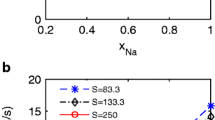Abstract
The relative potencies of saxitoxin at pH 7.25 and 8.25 have been determined on the squid giant axon under voltage-clamp conditions or by\(\dot V_{{\text{max}}} \) of the propagated action potential. Of the two guanidinium groups in saxitoxin, the 7, 8, 9 group has been identified as the biologically active group. The evidence lies in the demonstration of a quantitative agreement between the relative abundance of the protonated, positively charged form of that group at pH's 7.25 and 8.25 (ratio 1.80) with the relative potencies (ratio 1.79) of the toxin. The 1, 2, 3 group is excluded by the lack of agreement between the relative abundance of the protonated form (ratio 1.00) and the relative potencies at these pH's.
The 1, 2, 3 group is further excluded by the observation that neosaxitoxin is equally potent at pH 6.50 and 7.25, in spite of a difference of 6-fold in the abundance of a deprotonated hydroxyl group on N-1 which should have influenced the potency.
Similar content being viewed by others
References
Bordner J, Thiessen WE, Bates HA, Rapoport H (1975) The structure of a crystalline derivative of saxitoxin: the structure of saxitoxin. Am J Chem Soc 97: 6008–6012
Camougis G, Takman BH, Tasse JRP (1967) Potency difference between the zwitterion form and the cation forms of tetrodotoxin. Science 156: 1625–1627
Cuervo LA, Adelman WJ (1970) Equilibrium and kinetic properties of the interaction between tetrodotoxin and the excitable membrane of the squid axon. J Gen Physiol 55: 309–355
Deguchi T (1976) Structure and activity in tetrodotoxin derivatives. Jap J Pharmacol 17: 267–278
Ghazarossian VE, Schantz EJ, Schnoes HK, Strong FM (1976) A biologically active acid hydrolysis product of saxitoxin. Biochem Biophys Res Comm 68: 776–780
Good NE, Winget GD, Winter W, Connolly TN, Izawa S, Singh RMM (1966) Hydrogen ion buffers for biological research. Biochem 5: 467–477
Goto T, Kishi Y, Takahashi S, Hirata Y (1965) Tetrodotoxin. Tetrahedron 21: 2059–2088
Hille B (1968) Pharmacological modifications of the sodium channels of frog nerve. J Gen Physiol 51: 199–219
Hille B (1975) The receptor for tetrodotoxin and saxitoxin: a structural hypothesis. Biophys J 15: 615–619
Hondeghem LM (1978) Validity of\(\dot V_{{\text{max}}} \) as a measure of the sodium current in cardiac and nervous tissues. Biophys. J 23: 147–152
Kao CY (1983) New perspectives on the interactions between tetrodotoxin and saxitoxin with the excitable membrane. Toxicon Supplement 3: 211–219
Kao CY, Nishiyama A (1965) Actions of saxitoxin on peripheral neuromuscular systems. J Physiol (London) 272: 50–66
Kao CY, Walker SE (1982) Active groups of saxitoxin and tetrodotoxin as deduced from actions of saxitoxin analogues on frog muscle and squid axon. J Physiol (London) 323: 619–637
Kao PN, James-Kracke MR, Kao CY, Wichtman CF, Schnoes HK (1981) Identification of the active guanidinium group in saxitoxin. Biol Bull 161: 347
Koehn FE, Ghazarossian VE, Schantz EJ, Schnoes HK, Strong FM (1981) Derivatives of saxitoxin. Bioorganic Chem 10: 412–428
Mosher HS, Fuhrman FA, Buchwald HD, Fischer HG (1964) Tarichatoxin-tetrodotoxin, a potent neurotoxin. Science 144: 1100–1110
Narahashi T, Haas HG, Therrien EF (1967) Saxitoxin and tetrodotoxin: comparison of nerve blocking mechanism. Science 157: 1441–1442
Narahashi T, Moore JW, Frazier DT (1969) Dependence of tetrodotoxin blockage of nerve membrane conductance on external pH. J Pharmacol Exp Therap 169: 224–228
Ritchie JM, Rogart RB (1977) The binding of saxitoxin and tetrodotoxin to excitable tissues. Rev Physiol Biochem Pharmacol 79: 1–50
Rogers RS, Rapoport H (1980) The pKa's of saxitoxin. J Am Chem Soc 102: 7335–7339
Schantz EJ, Ghazarossian VE, Schnoes HK, Strong FM, Springer JP, Pezzanite JO, Clardy J (1975) The structure of saxitoxin. J Am Chem Soc 97: 1238–1239
Schwarz JR, Ulbricht W, Wagner HH (1973) The rate of action of tetrodotoxin on myelinated nerve fibres ofXenopus laevis andRana esculenta. J Physiol (London) 233: 167–194
Shimizu Y, Alam M, Oshima Y, Fallon WE (1975) Presence of four toxins in red-tide infested clams and culturedGonyaulux tamarensis cells. Biochem Biophys Res Comm 66: 731–737
Shimizu Y, Hsu C, Genenah A (1981) Structure of saxitoxin in solution and stereochemistry of dihydrosaxitoxins. J Am Chem Soc 103: 605–609
Shimizu Y, Hsu C, Fallon WE, Oshima Y, Miura I, Nakanishi K (1978) Structure of neosaxitoxin. J Am Chem Soc 100: 6791–6793
Stillman IM, Gilbert DL, Lipicky RJ (1971) Effect of external pH upon the voltage-dependent currents of the squid giant axon. Biophys J 11: 55a
Tsuda K, Ikuma S, Kawamura M, Tachikawa R, Sakai K, Tamura C, Amakasu O (1964) Tetrodotoxin VII. On the structure of tetrodotoxin and its derivatives. Chem Pharm Bull 12: 1357–1374
Ulbricht W (1981) Kinetics of drug action and equilibrium results at the node of Ranvier. Physiol Rev 61: 785–828
Ulbricht W, Wagner HH (1975) The influence of pH on equilibrium effects of tetrodotoxin on myelinated nerve fibers ofRana esculenta. J Physiol (London) 252: 159–184
Wagner HH, Ulbricht W (1975) The rates of saxitoxin action and of saxitoxin-tetrodotoxin interaction at the node of Ranvier. Pflügers Arch 359: 297–315
Wichtman CF, Boyer GL, Divan CL, Schantz EJ, Schnoes HK (1981) Neurotoxins ofGonyaulux excavata and Bay of Fundy scallops. Tetrahedron Letters 22: 1941–1944
Wu CH, Narahashi T (1973) Mechanism of action of propranolol on squid axon membrane. J Pharmacol Exp Therap 184: 155–162
Wu CH, Narahashi T, Shimizu Y (1980) Actions of saxitoxin analogs on squid axon membrane. Abstracts Neurosci Soc 6: 174
Author information
Authors and Affiliations
Rights and permissions
About this article
Cite this article
Kao, P.N., James-Kracke, M.R. & Kao, C.Y. The active guanidinium group of saxitoxin and neosaxitoxin identified by the effects of pH on their activities on squid axon. Pflugers Arch. 398, 199–203 (1983). https://doi.org/10.1007/BF00657151
Received:
Accepted:
Issue Date:
DOI: https://doi.org/10.1007/BF00657151




